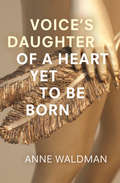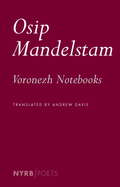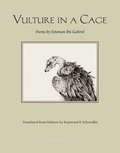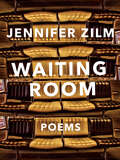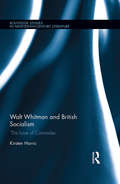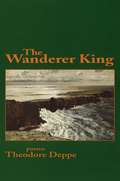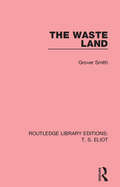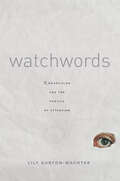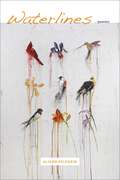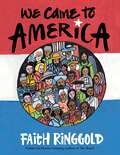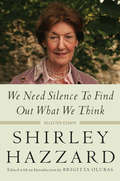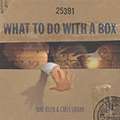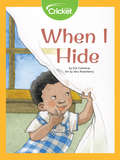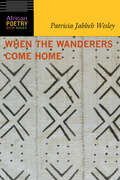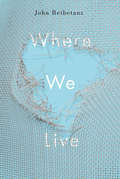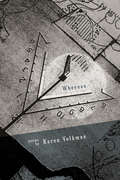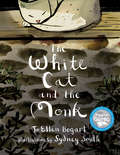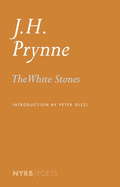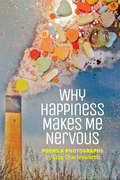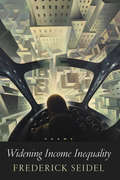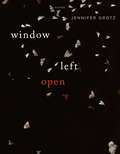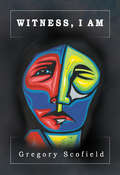- Table View
- List View
Voice's Daughter of a Heart Yet To Be Born
by Anne WaldmanComing in the wake of her vast and magnificent epic (The Iovis Trilogy: Colors in the Mechanism of Concealment), this volume brings Anne Waldman’s work into the more intimate, paradoxical folds of poetic (and prophetic) knowledge. This should not suggest that Voice's Daughter of a Heart Yet to Be Born is a book of small things; it is anything but. Juxtaposing lyric arcana, journalism, critical fragments, visions of mythic and mystic beings, narrative, polemics, and even ekphrasis, Waldman has created a work that is simultaneously jeremiad and psalm. It is, then, both fearful and celebratory, an epic of a ‘time before birth.’
Voronezh Notebooks
by Osip Mandelstam Andrew DavisOsip Mandelstam is one of the greatest twentieth-century poets in any language, and his work, which sounds the depths of the Russian language, has presented a fertile and constant challenge to translators. Composed after Mandelstam's unexpected release from Stalin's prisons, Voronezh Notebooks covers two years of his life, from the spring of 1935, when in a state of physical and mental collapse he traveled south into exile with his wife, to May 1937, not long before the couple was allowed to return to Moscow (which was followed by Mandelstam's final arrest), and the poems constitute a single sequence and a kind of last testament. Meditating on death and survival, on the powers that be and the power of poetry, on marriage, friendship, and memory, challenging Stalin between lines that are full of the sights and sounds of the steppes, blue sky and black earth, the roads, winter breath, spring with its birds and flowers and bees, the notebooks are a continual improvisation and unapologetic affirmation of poetry as life. The extraordinary concentration, powerful imagery, and strange echoing music of Mandelstam's sequence come forth in English as never before in Andrew Davis's inspired new translation.
Vulture in a Cage: Poems by Solomon Ibn Gabirol
by Raymond P. Scheindlin Solomon Ibn Gabirol"Vulture in a cage," Solomon Ibn Gabirol's own self-description, is an apt image for a poet who was obsessed with the impediments posed by the body and the material world to the realization of his spiritual ambition of elevating his soul to the empyrean. Ibn Gabirol's poetry is enormously influential, laying the groundwork for generations of Hebrew poets who follow him--rocky and harsh, full of original imagery and barbed wit, and yet no one surpassed him for the limpid beauty of his devotional verse. His poetry is at once a record of the inner life of a tormented poet and a monument to the Judeo-Arabic culture that produced him. This book contains the most extensive collection of Ibn Gabirol's poetry ever published in English.From the Trade Paperback edition.
Waiting Room
by Jennifer ZilmYou’re welcome to take a seat in (the) Waiting Room, the first full-length collection of poetry from award-winning writer Jennifer Zilm. Featuring a mélange of styles and forms (sonnets, erasures, unsent emails, footnotes, session notes, CVs, tweets, and other disparate source materials—including, the Gospels and the Dead Sea Scrolls), Waiting Room subverts, shares, and repurposes the vocabularies of psychiatry, dentistry, the Bible, and academia in a humorous investigation of the contained intimacy of appointments and therapeutic relationships. Ultimately interested in how we learn, the experimental and lyrical poems in Waiting Room seek lessons in what it means to wait, to be a patient and to be patient, to be a student and to be a teacher, to be a healer and to be healed. In four unique sections, Zilm invites readers to investigate the curious boundaries of various therapeutic terrains—from an exploration of the esoteric world of graduate school, where the subject is religion, to a mash-up of Dante’s vision of purgatory and Vancouver’s Downtown Eastside (DTES), to the improbable written intersections of van Gogh's doctors and Sylvia Plath's therapist.Lovers of avant-garde and lyrical poetry will immediately connect with Zilm's engaging, observant, and probing work, as will readers familiar with the realms of Vancouver's neighbourhoods, in particular the DTES. And because of its many idiomatic forms (e.g., emails, tweets, recipes, etc.), its integration of a wide range of source materials, and its relatable settings and subject matter, Waiting Room could serve as a "gateway collection" for readers who don’t always connect with poetry, but enjoy other forms of literature.
Walt Whitman and British Socialism: ‘The Love of Comrades’ (Routledge Studies in Nineteenth Century Literature)
by Kirsten HarrisThis is the first sustained examination of Walt Whitman’s influence on British socialism. Harris combines a contextual historical study of Whitman’s reception with focused close readings of a variety of poems, books, articles, letters and speeches. She calls attention to Whitman’s own demand for the reader to ‘himself or herself construct indeed the poem, argument, history, metaphysical essay’, linking Whitman’s general comments about active reading to specific cases of his fin de siècle British socialist readership. These include the editorial aims behind the Whitman selections published by William Michael Rossetti, Ernest Rhys, and W. T. Stead and the ways that Whitman was interpreted and appropriated in a wide range of grassroots texts produced by individuals or groups who responded to Whitman and his poetry publicly in socialist circles. Harris makes full use of material from the C. F. Sixsmith and J. W. Wallace and the Bolton Whitman Fellowship collections at John Rylands, the Edward Carpenter collection in the Sheffield Archives, and the Archives of Swan Sonnenschein & Co. at the University of Reading. Much of this archive material – little of which is currently available in digital form – is discussed here in full for the first time. Accordingly, this study will appeal to those with interest in the archival history of nineteenth-century literary culture, as well as the connections to be made between literary and political culture of this era more generally.
The Wanderer King
by Theodore Deppe"In these elegant and searing poems, Theodore Deppe gives voice to the full complexity of human character, creating a world that is charged and expansive. With cinematic vividness and stunning eloquence, these poems examine the tensions between hope and despair, responsibility and mystery - as if a sacred universe we were in danger of losing had been stayed at the moment of vanishing. The dramatic monologues are a triumph of the imagination." --Betsy Sholl
The Waste Land (Routledge Library Editions: T. S. Eliot Ser. #8)
by Grover SmithIn this study, first published in 1983, Professor Smith makes the argument that although The Waste Land is analogous in form to a musical composition that it is actually made of its literary echoes. He calls these a ‘music of allusions’ and shows the resemblance of this music in its evocativeness to the technique of Mallarmé and the French symbolists. Smith also comments extensively on Eliot’s critical theories as they bear on The Waste Land and traces the development of Eliot’s allusive and transformational poetic form from its genesis in early work. This title will be of interest to students of literature.
Watchwords: Romanticism and the Poetics of Attention
by Lily Gurton-WachterThis book revisits British Romanticism as a poetics of heightened attention. At the turn of the nineteenth century, as Britain was on the alert for a possible French invasion, attention became a phenomenon of widespread interest, one that aligned and distinguished an unusual range of fields (including medicine, aesthetics, theology, ethics, pedagogy, and politics). Within this wartime context, the Romantic aesthetic tradition appears as a response to a crisis in attention caused by demands on both soldiers and civilians to keep watch. Close formal readings of the poetry of Blake, Coleridge, Cowper, Keats, (Charlotte) Smith, and Wordsworth, in conversation with research into Enlightenment philosophy and political and military discourses, suggest the variety of forces competing for--or commanding--attention in the period. This new framework for interpreting Romanticism and its legacy illuminates what turns out to be an ongoing tradition of war literature that, rather than give testimony to or represent warfare, uses rhythm and verse to experiment with how and what we attend to during times of war.
Waterlines: Poems
by Alison PelegrinIn Waterlines, Louisiana native Alison Pelegrin gives us poems that describe the terrible power of nature even as they underscore the state’s beauty. The poet moves from the familiar gaudy delights of life in New Orleans to immerse the reader in the vastly different experience of living north of Lake Pontchartrain. In this fractured world, the Bogue Falaya River becomes a highway paved with benedictions, psalms, and praise for ordinary things, as Pelegrin searches the unfamiliar for an incarnation of home. Water—the threat of hurricanes and floods, as well as the tangled geographies and histories of the rivers and lakes themselves—sustains the poet as she settles into the casual beauty of “the daily route,” finding spiritual depth and delight in both human and natural wonders. “It’s said that figures as different as Jefferson and Goethe were comfortable in the world because they were at home at Monticello and Weimar respectively, and the same is true of Alison Pelegrin. Waterlines starts locally and then radiates outward, not geographically so much as emotionally and spiritually. There are poems about faith, poems of wry and even scary self-examination, poems that combine these themes and more. Pelegrin stays close to her roots yet journeys out and back, ranging widely and then coming home to tap strength and sustenance.
We Came to America
by Faith RinggoldA timely and beautiful look at America&’s rich history of diversity, from Faith Ringgold, the Coretta Scott King and Caldecot Honor winning creator of Tar Beach From the Native Americans who first called this land their home, to the millions of people who have flocked to its shores ever since, America is a country rich in diversity. Some of our ancestors were driven by dreams and hope. Others came in chains, or were escaping poverty or persecution. No matter what brought them here, each person embodied a unique gift—their art and music, their determination and grit, their stories and their culture. And together they forever shaped the country we all call home. Vividly expressed in Faith Ringgold&’s sumptuous colors and patterns, We Came to America is an ode to every American who came before us, and a tribute to each child who will carry its proud message of diversity into our nation&’s future. PRAISE FOR WE CAME TO AMERICA: &“As Americans wrestle with the moral and legal aspects of immigration, Ringgold offers a reminder of the country&’s multifaceted lineage—and of the beauty to be discovered at cultural crossroads…. The simplicity of Ringgold&’s text, combined with the captivating designs, makes this a compelling, must-have narrative for a wide audience.&” –School Library Journal, starred review &“Using a broad brush and folk style familiar from her story quilts, Ringgold pictures families of diverse heritage… her powerful voice emphasizes unity and mutual appreciation.&” –Publishers Weekly &“[A] timely look at the diverse makeup and backgrounds of the American people.&” –Booklist
We Need Silence to Find Out What We Think: Selected Essays
by Shirley Hazzard Brigitta OlubasThese nonfiction works span from the 1960s to the 2000s and were produced by one of the great fiction writers of the period. They add critical depth to Shirley Hazzard's creative world and encapsulate her extensive and informed thinking on global politics, international relations, the history and fraught present of Western literary culture, and postwar life in Europe and Asia. They also offer greater access to her brilliant craftsmanship and the multiple registers in which her writings operate. Hazzard writes about the manifold failings of the United Nations, where she worked in the early 1950s. She shares her personal experience with the aftermath of the Hiroshima bombings and the nature of life in late-1940s Hong Kong. She presents her thoughts on the decline of the hero as a public figure in Western literature. These works contribute to a keener understanding of postwar letters, thought, and politics, supported by an introduction that situates Hazzard's writing within its historical context and emphasizes her influence on world literature. This collection confirms Hazzard's place within a network of writers, artists, and intellectuals who believe in the ongoing power of literature to console, inspire, and direct human life, despite-or maybe because of-the world's disheartening realities.
What To Do With a Box
by Jane YolenIf you give a child a box, who can tell what will happen next? It may become a library or a boat. It could set the scene for a fairy tale or a wild expedition. The most wonderful thing is its seemingly endless capacity for magical adventure, a feature imaginatively captured in cardboardesque art by Chris Sheban and rhythmically celebrated in this poetic tribute by renowned children's author Jane Yolen.
When the Wanderers Come Home (African Poetry Book)
by Patricia Jabbeh WesleyDescribed by African scholar and literary critic Chielozona Eze as “one of the most prolific African poets of the twenty-first century,” Patricia Jabbeh Wesley composed When the Wanderers Come Home during a four-month visit to her homeland of Liberia in 2013. She gives powerful voice to the pain and inner turmoil of a homeland still reconciling itself in the aftermath of multiple wars and destruction. Wesley, a native Liberian, calls on deeply rooted African motifs and proverbs, utilizing the poetics of both the West and Africa to convey her grief. Autobiographical in nature, the poems highlight the hardships of a diaspora African and the devastation of a country and continent struggling to recover. When the Wanderers Come Home is a woman’s story about being an exile, a survivor, and an outsider in her own country; it is her cry for the Africa that is being lost in wars across the continent, creating more wanderers and world citizens.
Where Do Steam Trains Sleep at Night? (Where Do...Series)
by Brianna Caplan SayresThe same team who brought you Where Do Diggers Sleep at Night? have engineered another rollicking bedtime story—for train lovers everywhere! Have you ever wondered what little trains do when it&’s time for bed? The same things you do! Freight trains, passenger trains, subways, trolleys—and more—wash up, have a snack, load their teddies for story time, and get rocked to sleep by mommy and daddy trains beneath a blanket of stars. Little train lovers with a one-track mind will gain a new affinity for their bedtime routine when they find they share it with their favorite vehicles. &“Sayres and Slade move naturally from their truck lullaby, Where Do Diggers Sleep at Night? , to this nighttime serenade to all things train. Hopeful engineers will want to be able to identify the many different types of trains, and their out-of-the-know adults will appreciate this inclusive primer.&” —Kirkus Reviews
Where We Live
by John Reibetanzshell in the night sky / and whose anti-clockwise spiral / repeats the Milky Way's unwinding / informed not with the lore of clocks or teachers / but of gods and children Where We Live explores how specific places and their features (street scenes, classrooms, furniture, creatures both real and mythical) become part of our identities, and illustrates how we carry them around and how we are shaped by their outlines even as we, in turn, transform them. This reciprocity extends to the adoption of other voices in the translated poems that are a vital part of each section, and to the active participation of the reader invited by the collection's flexible use of poetic form. John Reibetanz's approach comes from a conviction that the most compelling and significant features of human identity are not primarily found in solitude but rather evolve through our conversations with otherness. This collection works as a kind of long poem, its three parts interconnected, each presenting a particular interpretation of the process of possession, loss, and recovery. "Thresholds" deals with encounters between the self and the other - childhood experiences, family, familiar places - and seeks ways of transcending the disappointment within such sources. "Roommates" explores both the uniqueness and the reciprocity in human relationships with the natural world, and "Flyways" posits that there is no separation between the human/natural and the imaginative: however far-flung, they all interweave and constitute the territory where we live.
Where We Live (Hugh MacLennan Poetry Series #8)
by John Reibetanzshell in the night sky / and whose anti-clockwise spiral / repeats the Milky Way’s unwinding / informed not with the lore of clocks or teachers / but of gods and children Where We Live explores how specific places and their features (street scenes, classrooms, furniture, creatures both real and mythical) become part of our identities, and illustrates how we carry them around and how we are shaped by their outlines even as we, in turn, transform them. This reciprocity extends to the adoption of other voices in the translated poems that are a vital part of each section, and to the active participation of the reader invited by the collection’s flexible use of poetic form. John Reibetanz’s approach comes from a conviction that the most compelling and significant features of human identity are not primarily found in solitude but rather evolve through our conversations with otherness. This collection works as a kind of long poem, its three parts interconnected, each presenting a particular interpretation of the process of possession, loss, and recovery. “Thresholds” deals with encounters between the self and the other – childhood experiences, family, familiar places – and seeks ways of transcending the disappointment within such sources. “Roommates” explores both the uniqueness and the reciprocity in human relationships with the natural world, and “Flyways” posits that there is no separation between the human/natural and the imaginative: however far-flung, they all interweave and constitute the territory where we live.
Whereso
by Karen VolkmanKnown for the transcendent, abstractionist poems of Nomina, Volkman's newest collection returns to tangible experiences of the body—its range of expressivity and physical movement in space. Where is the body in travel? What space does it occupy in dreams and memory? With rich perplexity, Whereso responds to dance, performance, and position in time—translating flight of the body into language and line.Karen Volkman is the author of Crash's Law, winner of the National Poetry Series; Spar, winner of the Iowa Poetry Prize and the James Laughlin Award; and Nomina. She teaches at the University of Montana in Missoula, Montana.
The White Cat and the Monk: A Retelling of the Poem “Pangur Bán”
by Jo Ellen BogartA monk leads a simple life. He studies his books late into the evening and searches for truth in their pages. His cat, Pangur, leads a simple life, too, chasing prey in the darkness. As night turns to dawn, Pangur leads his companion to the truth he has been seeking.The White Cat and the Monk is a retelling of the classic Old Irish poem “Pangur Bán.” With Jo Ellen Bogart’s simple and elegant narration and Sydney Smith’s classically inspired images, this contemplative story pays tribute to the wisdom of animals and the wonders of the natural world.
The White Stones
by J. H. Prynne Peter GizziJ. H. Prynne is Britain's leading late-modernist poet. His work, as it has emerged since the 1960s, when he was close to Charles Olson and Edward Dorn, is marked by a remarkable combination of lyricism and abstraction, at once austere and playful. The White Stones is a book that is central to Prynne's career and poetics, and it constitutes an ideal introduction to the achievement and vision of a legendary but in America still little-known contemporary master.
Why Happiness Makes Me Nervous
by Liza CharlesworthIn words and pictures, Liza Charlesworth's new book, Why Happiness Makes Me Nervous, captures the poetic journey of a girl's complicated coming of age. Loneliness, divorce, loss, love, burgeoning sexuality, and those awkward, epic years between adolescent and adulthood are explored in the pairing of these riveting poems and vivid photographs.
Widening Income Inequality: Poems
by Frederick Seidel"One of the world's most inspired and unusual poets . . . [Seidel's] poems are a triumph of cosmic awe in the face of earthly terror." --Hillel Italie, USA TodayFrederick Seidel has been called many things. A "transgressive adventurer," "a demonic gentleman," a "triumphant outsider," "a great poet of innocence," and "an example of the dangerous Male of the Species," just to name a few. Whatever you choose to call him, one thing is certain: "he radiates heat" (The New Yorker). Now add to that: the poet of aging and decrepitude. Widening Income Inequality, Seidel's new poetry collection, is a rhymed magnificence of sexual, historical, and cultural exuberance, a sweet and bitter fever of Robespierre and Obamacare and Apollinaire, of John F. Kennedy and jihadi terror and New York City and Italian motorcycles. Rarely has poetry been this true, this dapper, or this dire. Seidel is "the most poetic of the poets and their leader into hell."
Window Left Open: Poems
by Jennifer GrotzThe poppies are wild, they are only beautiful and tallso long as you do not cut them,they are like the feral cat who purrs and rubs against your legbut will scratch you if you touch back.Love is letting the world be half-tamed.--from "Poppies"In this lush, intricately crafted collection, Jennifer Grotz explores how we can become strange to ourselves through escape, isolation, desire--and by leaving the window open. These poems are full of the sensory pleasures of the natural world and a slowed-down concept of time as Grotz records the wonders of travel, a sojourn at a French monastery, and the translation of thoughts into words, words into another language, language into this remarkable poetry. Window Left Open is a beautiful and resounding book, one that traces simultaneously the intimacy and the vastness of the world.
Winter, Winter, Cold and Snow
by Sharon Gibson PalermoA gentle, repetitive story about forest creatures on a cold winter's day and night. With colorful, child-friendly illustrations this is a sweet pick for cozy storytimes by the fire.
Witness, I Am
by Gregory ScofieldWitness, I Am is divided into three gripping sections of new poetry from one of Canada's most recognized poets. The first part of the book, "Dangerous Sound," contains contemporary themed poems about identity and belonging, undone and rendered into modern sound poetry. "Muskrat Woman," the middle part of the book, is a breathtaking epic poem that considers the issue of missing and murdered indigenous women through the reimagining and retelling of a sacred Cree creation story. The final section of the book, "Ghost Dance," raids the autobiographical so often found in Scofield's poetry, weaving the personal and universal into a tapestry of sharp poetic luminosity. From "Killer," Scofield eerily slices the dreadful in with the exquisite: "I could, this day of proficient blooms, / take your fingers, / tie them down one by one. This one for the runaway, / this one for the joker, / this one for the sass-talker, / this one for the judge, / this one for the jury. / Oh, I could kill you."
